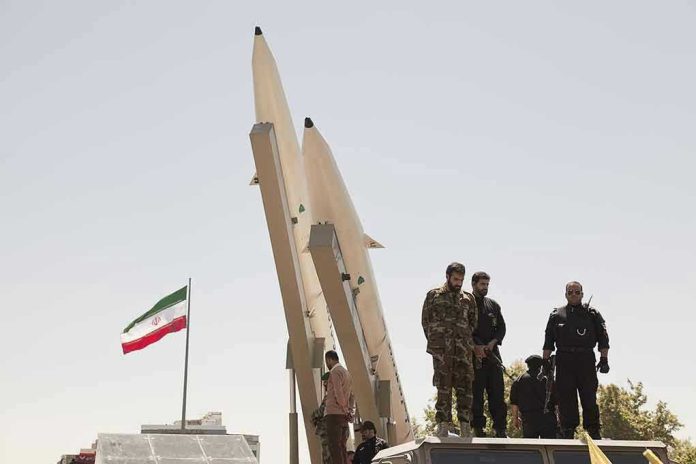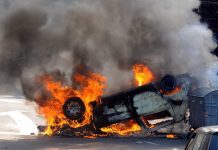
Iran’s public unveiling of its ballistic missiles and Shahed-116 drones just months after direct conflict with Israel signals a new era of military brinkmanship, leaving regional powers and global observers questioning what comes next—and who might be next in line for escalation.
Story Snapshot
- Iran showcased ballistic missiles and advanced drones for the first time after the April 2025 war with Israel.
- The Shahed-116 drone display highlighted Iran’s evolving deterrence strategy and foreign-supplied technology.
- International reactions included new US sanctions and heightened scrutiny of Iran’s weapons supply chain.
- Regional tensions amplified, raising stakes for future arms races and proxy conflicts.
Iran’s Military Parade: Power Display or Provocation?
November 2025 witnessed an unprecedented military parade in Tehran: Iran’s government and the Islamic Revolutionary Guard Corps (IRGC) rolled out their latest ballistic missiles alongside the Shahed-116 drone, a system reportedly integrating foreign-supplied components. The timing, barely seven months after open warfare with Israel, amplified the event’s significance. The world watched as Iran’s Supreme Leader stood before the nation, sending an unmistakable message: deterrence and resilience now anchor Iran’s regional posture.
Israel’s military and intelligence apparatus immediately scrutinized the new hardware, focusing on the Shahed-116’s reported foreign components and advanced targeting capabilities. The display, highly choreographed and widely broadcast, marked a sharp departure from previous, more restrained parades. Iranian officials underscored the moment as a demonstration of self-reliance, but international observers pointed to the visible evidence of imported parts, fueling calls for supply chain accountability and sanctions enforcement.
Origins of Iran’s Missile and Drone Ambitions
Iran’s missile and drone programs trace roots to decades of strategic necessity and technological adaptation. Facing conventional force limitations and regional adversaries—primarily Israel and the United States—Iran has poured resources into developing long-range missile systems and unmanned aerial vehicles. The April 2025 conflict provided stark validation for these investments, with both sides engaging in rapid missile and drone exchanges that tested air defenses and strategic resolve.
Proxy wars in Syria, Lebanon, and Gaza had previously defined Iran-Israel hostilities, but the direct confrontation in April shifted the paradigm. The months following the ceasefire saw Iran accelerate its weapons development, leveraging domestic innovation and foreign supply channels. US Treasury sanctions targeted entities supporting Iran’s drone program, yet the November parade revealed persistent gaps in international enforcement and the complexity of dual-use technology regulation.
Stakeholders and Power Dynamics in a Shifting Landscape
Iran’s Supreme Leader and IRGC leadership operate at the nexus of military decision-making, dictating both the pace and tone of weapons development. The Iranian Ministry of Defense, often working in tandem with covert procurement networks, ensures steady progress despite sanctions. Across the border, Israel’s government and military strategists respond with intelligence gathering and countermeasures, wary of both the hardware on display and the potential for proliferation to proxy forces.
The United States remains a central actor, balancing containment strategies with support for Israeli security. Recent sanctions highlight Washington’s intent, but questions linger about the effectiveness of such measures, given the evidence of foreign components in Iranian drones. Ukrainian companies have been cited as sources for parts, raising ethical and legal debates about the international arms supply chain. This web of interests creates a volatile power dynamic, where each player’s motivations—deterrence, security, profit—drive policy and action in unpredictable directions.
Escalation, Sanctions, and the Future of Deterrence
Iran’s parade triggered immediate diplomatic fallout. The US Treasury announced further sanctions on entities implicated in drone component supply, signaling ongoing commitment to restricting Iran’s technological advances. Iranian officials, meanwhile, declared the display a defensive gesture, necessary for national security and regional stability. The juxtaposition of these messages underscored the deep mistrust and divergent narratives shaping Middle Eastern geopolitics.
Short-term implications include increased vigilance by Israeli and US defense establishments, potential arms buildups in Gulf states, and growing anxiety among civilian populations in neighboring countries. Long-term, the region faces the prospect of an accelerated arms race, with advanced missile and drone systems increasingly normalized as tools of both deterrence and projection. The risk of proliferation to non-state actors—already demonstrated in Yemen, Iraq, and Syria—complicates efforts to contain escalation and secure international supply chains.
Expert Analysis and Competing Narratives
Military analysts regard Iran’s missile program as the cornerstone of its defense strategy, compensating for conventional military limitations and enabling asymmetric responses to external threats. The sophistication of the Shahed-116 drone, particularly its integration of foreign-supplied components, has drawn scrutiny from Western experts, who highlight the challenge of enforcing effective sanctions in a globalized technology market.
Academic perspectives stress the symbolic value of public displays, noting their role in consolidating domestic support and signaling resolve to adversaries. Iranian officials frame their actions as defensive, while Western analysts emphasize the destabilizing potential of unchecked proliferation and technological advancement. The Institute for the Study of War and US government statements offer authoritative frameworks for interpreting the display’s strategic implications, corroborated by media reports detailing both the parade and subsequent international reactions.
Sources:
Media coverage of Iran’s military showcase and foreign-supplied drone components









